Alan M. Petrillo
Central Pierce Fire & Rescue, in Northwestern Washington, has used Pierce Manufacturing Inc. apparatus for more than 15 years, so it is not surprising that the department turned to Pierce to replace an aging aerial. What was surprising was that it deviated from past specs and did not choose to put a pump or water tank on the new vehicle.
A Truckie’s Truck
Baron Banks, Central Pierce’s assistant chief of logistics, says the district’s other two aerial apparatus-a 2000 Pierce Dash 100-foot ladder and a Pierce Arrow XT 50-foot Telesqurt-each have a 1,500-gallon-per-minute (gpm) pump and 250-gallon water tank. “We’ve changed our philosophy in using an aerial ladder where we’re focusing our ladders on doing more truck type work on the fire scene but still having fire suppression capability.”
In the past, the 100-foot ladder would respond to calls much as a pumper would, Banks points out, but now it runs only on structure fires and support for heavy rescue. “Our main focus is using it for truck operations at structure fires and for extrication work,” he says.
For the department’s new aerial ladder apparatus, Central Pierce Fire & Rescue approached Pierce about building an aerial ladder that didn’t carry a pump or water tank yet still had fire suppression ability. The fire district wanted something else too-idle reduction technology (IRT) that allowed firefighters to save wear and tear on the vehicle’s main engine while improving its carbon footprint.
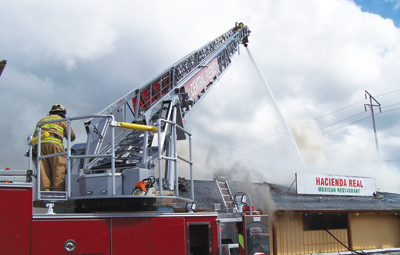 |
|
(1) Central Pierce (WA) Fire & Rescue put its new Pierce Manufacturing |
Pierce’s answer was a 105-foot Arrow XT aerial ladder with a 750-pound tip load and 1,250-gpm waterway that incorporated IRT using a 20-horsepower (hp) Kubota diesel generator and Tri-Max Super 60 compressed-air foam system (CAFS) for fire suppression capability. “Removing the pump and tank on the vehicle gave us a lot more space for compartmentation and storage that we use for our heavy rescue gear like rescue struts, torches, saws, special operations gear, ropes, and stokes baskets,” Banks points out.
He says the Tri-Max 60-gallon CAFS sits in the dunnage area above where the pump would have been located. “It’s like a large pressurized water fire extinguisher,” Banks notes. “The system is pressurized by three one-hour 4,500-psi self-contained breathing apparatus (SCBA) air bottles, flows for about two minutes, and can run from one to six percent solution.”
He adds that Central Pierce Fire & Rescue uses FireAide 2000 Class A/B foam in the system, “because we’ve found it takes a lot less product to blanket flammable liquids and there is no reignition.”
The Tri-Max system is connected to two accordion-loaded 100-foot hoselines-one on each side of the vehicle.
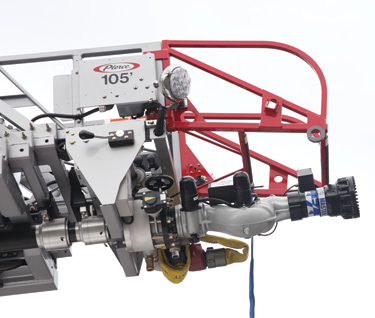 |
| (2) Central Pierce Fire & Rescue’s new Pierce Arrow XT aerial ladder carries a Task Force Tips Monsoon 1,250-gpm remote-controlled monitor at the tip of its waterway. |
Less Weight, More Storage
Dan Hays of Hughes Fire Equipment Inc., the dealer who sold Central Pierce the apparatus, says eliminating the water tank and pump from the vehicle not only saved money for the district but also reduced the weight of the vehicle, allowing the department the space to carry much more equipment.
“The state of Washington has very strict vehicle weight laws,” Hays says. “Firefighters always want to carry more equipment on their vehicles, but on a tandem axle the maximum weight you can put on it is 43,000 pounds, although you can apply for a special permit allowing up to 50,000 pounds.”
Andy Siebers, Pierce Manufacturing’s requirements manager, says that the district’s desire to reduce the amount of time the vehicle’s engine idles at the scene and to be able to provide fire suppression assistance at a scene without having water or a pump on the unit were the particular requirements facing Pierce.
“The sales representative and the committee members from Central Pierce were a great group of people to work with on this build,” Siebers says. “They understood the difficulties that we faced with the fit of all the requested items to be installed on this truck and worked with Pierce to find common solutions.”
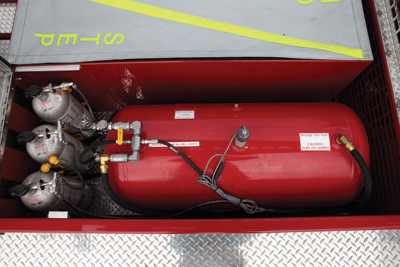 |
| (3) The aerial doesn’t carry a pump or water tank but has a Tri-Max 60- gallon CAFS driven by three one-hour 4,500-psi air bottles. |
Besides the Tri-Max foam system, the other solution the group agreed on was installing Pierce’s IRT. Lisa Barwick, Pierce’s market manager for cab, chassis, and electrical, says Pierce’s IRT uses an auxiliary power unit (APU), in this case a 20-hp Kubota diesel generator, “to power critical on-scene loads when the main chassis diesel engine is shut down.” She notes, “Pierce’s idle reduction system is engineered to reduce fuel consumption, reduce service intervals over the lifetime of the apparatus, and reduce the chassis diesel engine idle time.”
Banks points out that after the Arrow XT’s main chassis engine has been idling for 10 minutes, without the aerial engaged, the idle reduction technology system automatically switches on the generator to power all the electrical equipment on the vehicle and shuts down the main engine. “Not only does it save fuel and wear and tear on the main engine,” Banks says, “it also helps us reduce our carbon footprint in the environment.”
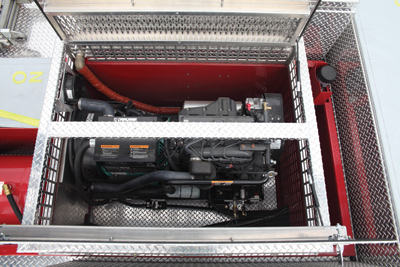 |
| (4) Pierce installed its IRT APU, which automatically turns off the idling main chassis engine after 10 minutes if it is not being used for water flow or to operate the aerial and runs all the electrical elements on the vehicle in its place. |
Day One IRT Field Test
The new Pierce Arrow XT aerial ladder proved its worth right from the day it was put in service. Dan Curnutt, the lieutenant on Ladder 61 being replaced by the new Arrow XT, and his crew had just finished transferring the equipment from the retired vehicle to the new Arrow XT and were heading out to fill the diesel fuel tank, which was only 1⁄8 full, when they were dispatched to a structure fire.
Curnutt’s reports, “Off we went on the new truck’s very first call to a 4,500-square-foot restaurant that we all knew could be problematic in a fire.” He continues, “Soon we had direction to back in at the northwest corner of the building through the adjacent business parking lot.”
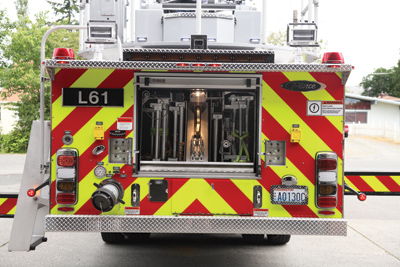 |
| (5) Six ground ladders are nested in an enclosed ladder tunnel at the rear of the new aerial. |
Curnutt and Firefighter Jim Girt hopped out of the vehicle wearing SetCom wireless intercom headsets and directed driver-paramedic Marc Beal to the truck’s setup position. “Immediately I appreciated how nice it is to chat through the wireless headsets as if we were all still in the cab together,” Curnutt observes in his report. “There was no need to turn on my portable radio since the headsets [connect via] Bluetooth to the truck’s more powerful mobile radio.”
Beal raised the aerial while a crew connected a supply line from the Tacoma (WA) Fire Department’s Engine 10. “Engine 10 pumped 27,000 gallons of water to us, and Girt at the ladder tip knocked the fire down,” Curnutt reports. “I walked three sides of the fire numerous times while still talking to the ladder guys and command with the headset.”
The IRT on the truck actually saved the day. The truck had gone into idle reduction, which was a good thing, Curnutt notes, because the fuel tank analog gauge read “empty” while its digital gauge blinked “critical” with three percent fuel remaining. “Without the IRT, I knew we would have been out of fuel,” he says.
After extinguishment, command allowed the new ladder to leave the scene and fill its main diesel tank and return to the fire building to assist with overhaul.
ALAN M. PETRILLO is a Tucson, Arizona-based freelance writer and is a member of the Fire Apparatus & Emergency Equipment editorial advisory board. He served 22 years with the Verdoy (NY) Fire Department, including in the position of chief.
Pierce Manufacturing Arrow XT Ladder
- Pierce Arrow XT 2010 chassis
- Five-person, 81-inch extended Arrow XT cab with notched raised roof
- 105-foot steel aerial ladder with 750-pound tip load
- 260-inch wheelbase
- 42-foot, 5½-inch overall length
- 11-foot, 11-inch overall height
- Front and side air bags
- Transverse compartment under forward-facing seat with roll-out tray for long tools
- Two EMS cabinets with Gortite roll-up doors in rear-facing seat positions
- Pierce Idle Reduction Technology (IRT) powered by Kubota 20-hp diesel generator
- 60-gallon Tri-Max CAFS
- Two 100-foot one-inch handlines
- Task Force Tips Monsoon 1,250-gpm remote-controlled monitor
- One 45-foot Duo-Safety three-section extension ladder
- One 35-foot Duo-Safety three-section extension ladder
- One 24-foot Duo-Safety two-section extension ladder
- One 16-foot Duo-Safety roof ladder
- One 10-foot Duo-Safety roof ladder
- One 10-foot Do-Safety folding ladder
- SetCom wireless intercom system
- Six Whelen Pioneer 12-volt PFP2 floodlights
- Two Fire Research Corporation 120-volt 900-watt Optimum lights
- Rear digital video camera
Price without equipment: $708,500
Central Pierce (WA) Fire & Rescue
Strength: 287 paid firefighters, 12 stations, providing fire suppression, rescue, and emergency medical services.
Service area: Services approximately 198,110 citizens and covers 84 square miles encompassing the communities of Parkland, Midland, Spanaway, South Hill, Puyallup, Summit, and Frederickson.
Other apparatus: 2000 Pierce Dash 100-foot aerial ladder with 1,500-gpm pump, 250-gallon water tank; Pierce Arrow XT 50-foot telesqurt; Pierce air-light unit on a Saber chassis; 14 Pierce pumpers on Dash chassis; 10 Medtech medium-duty medic units; two battalion chief vehicles; hazardous materials and specialty response vehicles.

